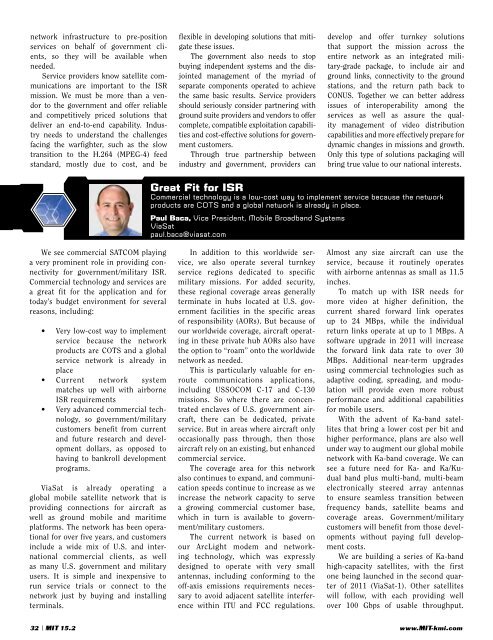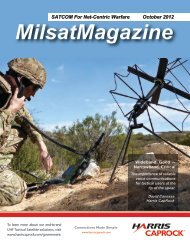Satcom for ISR - Harris CapRock
Satcom for ISR - Harris CapRock
Satcom for ISR - Harris CapRock
- No tags were found...
Create successful ePaper yourself
Turn your PDF publications into a flip-book with our unique Google optimized e-Paper software.
network infrastructure to pre-position<br />
services on behalf of government clients,<br />
so they will be available when<br />
needed.<br />
Service providers know satellite communications<br />
are important to the <strong>ISR</strong><br />
mission. We must be more than a vendor<br />
to the government and offer reliable<br />
and competitively priced solutions that<br />
deliver an end-to-end capability. Industry<br />
needs to understand the challenges<br />
facing the warfighter, such as the slow<br />
transition to the H.264 (MPEG-4) feed<br />
standard, mostly due to cost, and be<br />
flexible in developing solutions that mitigate<br />
these issues.<br />
The government also needs to stop<br />
buying independent systems and the disjointed<br />
management of the myriad of<br />
separate components operated to achieve<br />
the same basic results. Service providers<br />
should seriously consider partnering with<br />
ground suite providers and vendors to offer<br />
complete, compatible exploitation capabilities<br />
and cost-effective solutions <strong>for</strong> government<br />
customers.<br />
Through true partnership between<br />
industry and government, providers can<br />
develop and offer turnkey solutions<br />
that support the mission across the<br />
entire network as an integrated military-grade<br />
package, to include air and<br />
ground links, connectivity to the ground<br />
stations, and the return path back to<br />
CONUS. Together we can better address<br />
issues of interoperability among the<br />
services as well as assure the quality<br />
management of video distribution<br />
capabilities and more effectively prepare <strong>for</strong><br />
dynamic changes in missions and growth.<br />
Only this type of solutions packaging will<br />
bring true value to our national interests.<br />
Great Fit <strong>for</strong> <strong>ISR</strong><br />
Commercial technology is a low-cost way to implement service because the network<br />
products are COTS and a global network is already in place.<br />
Paul Baca, Vice President, Mobile Broadband Systems<br />
ViaSat<br />
paul.baca@viasat.com<br />
We see commercial SATCOM playing<br />
a very prominent role in providing connectivity<br />
<strong>for</strong> government/military <strong>ISR</strong>.<br />
Commercial technology and services are<br />
a great fit <strong>for</strong> the application and <strong>for</strong><br />
today’s budget environment <strong>for</strong> several<br />
reasons, including:<br />
• Very low-cost way to implement<br />
service because the network<br />
products are COTS and a global<br />
service network is already in<br />
place<br />
• Current network system<br />
matches up well with airborne<br />
<strong>ISR</strong> requirements<br />
• Very advanced commercial technology,<br />
so government/military<br />
customers benefit from current<br />
and future research and development<br />
dollars, as opposed to<br />
having to bankroll development<br />
programs.<br />
ViaSat is already operating a<br />
global mobile satellite network that is<br />
providing connections <strong>for</strong> aircraft as<br />
well as ground mobile and maritime<br />
plat<strong>for</strong>ms. The network has been operational<br />
<strong>for</strong> over five years, and customers<br />
include a wide mix of U.S. and international<br />
commercial clients, as well<br />
as many U.S. government and military<br />
users. It is simple and inexpensive to<br />
run service trials or connect to the<br />
network just by buying and installing<br />
terminals.<br />
In addition to this worldwide service,<br />
we also operate several turnkey<br />
service regions dedicated to specific<br />
military missions. For added security,<br />
these regional coverage areas generally<br />
terminate in hubs located at U.S. government<br />
facilities in the specific areas<br />
of responsibility (AORs). But because of<br />
our worldwide coverage, aircraft operating<br />
in these private hub AORs also have<br />
the option to “roam” onto the worldwide<br />
network as needed.<br />
This is particularly valuable <strong>for</strong> enroute<br />
communications applications,<br />
including USSOCOM C-17 and C-130<br />
missions. So where there are concentrated<br />
enclaves of U.S. government aircraft,<br />
there can be dedicated, private<br />
service. But in areas where aircraft only<br />
occasionally pass through, then those<br />
aircraft rely on an existing, but enhanced<br />
commercial service.<br />
The coverage area <strong>for</strong> this network<br />
also continues to expand, and communication<br />
speeds continue to increase as we<br />
increase the network capacity to serve<br />
a growing commercial customer base,<br />
which in turn is available to government/military<br />
customers.<br />
The current network is based on<br />
our ArcLight modem and networking<br />
technology, which was expressly<br />
designed to operate with very small<br />
antennas, including con<strong>for</strong>ming to the<br />
off-axis emissions requirements necessary<br />
to avoid adjacent satellite interference<br />
within ITU and FCC regulations.<br />
Almost any size aircraft can use the<br />
service, because it routinely operates<br />
with airborne antennas as small as 11.5<br />
inches.<br />
To match up with <strong>ISR</strong> needs <strong>for</strong><br />
more video at higher definition, the<br />
current shared <strong>for</strong>ward link operates<br />
up to 24 MBps, while the individual<br />
return links operate at up to 1 MBps. A<br />
software upgrade in 2011 will increase<br />
the <strong>for</strong>ward link data rate to over 30<br />
MBps. Additional near-term upgrades<br />
using commercial technologies such as<br />
adaptive coding, spreading, and modulation<br />
will provide even more robust<br />
per<strong>for</strong>mance and additional capabilities<br />
<strong>for</strong> mobile users.<br />
With the advent of Ka-band satellites<br />
that bring a lower cost per bit and<br />
higher per<strong>for</strong>mance, plans are also well<br />
under way to augment our global mobile<br />
network with Ka-band coverage. We can<br />
see a future need <strong>for</strong> Ka- and Ka/Kudual<br />
band plus multi-band, multi-beam<br />
electronically steered array antennas<br />
to ensure seamless transition between<br />
frequency bands, satellite beams and<br />
coverage areas. Government/military<br />
customers will benefit from those developments<br />
without paying full development<br />
costs.<br />
We are building a series of Ka-band<br />
high-capacity satellites, with the first<br />
one being launched in the second quarter<br />
of 2011 (ViaSat-1). Other satellites<br />
will follow, with each providing well<br />
over 100 Gbps of usable throughput.<br />
32 | MIT 15.2<br />
www.MIT-kmi.com




